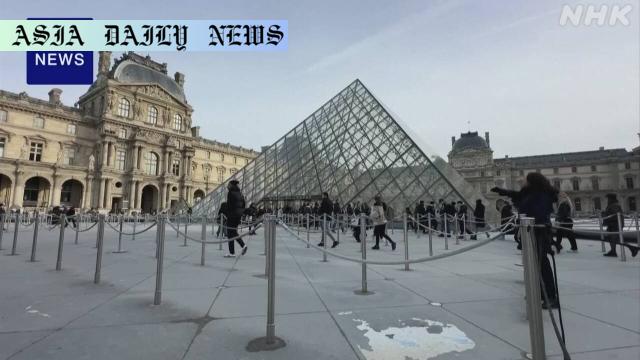Louvre unveils €800M renovation to ease visitor congestion and enhance infrastructure, with highlights including a new entrance by 2031.
Macron unveils a €800 million renovation plan for the Louvre.
Plan aims to address aging infrastructure and visitor congestion.
Highlights include a dedicated space for Mona Lisa and a new entrance.
Completion expected by 2031 with partial operations ongoing.
Higher non-EU visitor fees to start from January 2026.

French President Emmanuel Macron recently revealed a transformative renovation plan for the iconic Louvre Museum in Paris, signaling a major step in addressing the operational challenges of one of the world’s most visited museums. The ambitious project, estimated to cost between €700 to €800 million (approximately $730 to $835 million), is designed to alleviate visitor congestion and modernize the museum’s aging infrastructure while still preserving its historical significance. Set to span nearly a decade, the initiative highlights France’s dedication to maintaining the Louvre as a cultural and historical beacon.
Preserving a National Treasure
The Louvre has long stood as a testament to cultural preservation and historical grandeur, attracting an impressive 8.7 million visitors in 2022 alone. However, as its popularity continues to soar, so do challenges related to tourist overcrowding and aging facilities. President Macron’s announcement, made in the iconic museum itself, underscores the French government’s commitment to sustaining the Louvre’s reputation as a global cultural hub. The renovation plan specifically addresses infrastructure repairs and visitor management, ensuring that the museum remains an accessible and enriching experience for years to come.
Key Features of the Renovation
One of the stand-out aspects of the renovation is a dedicated area for Leonardo da Vinci’s celebrated masterpiece, the Mona Lisa. Currently exhibited in a room that often becomes overcrowded, this new space aims to enhance the viewing experience for millions of art enthusiasts. Additionally, a modernized entrance will be constructed to better manage visitor flow, a significant improvement that is expected to ease congestion and create a more welcoming atmosphere.
The museum’s operations will largely continue during the renovation, balancing the need for urgent changes with uninterrupted accessibility for the public. This ensures that visitors can still immerse themselves in the Louvre’s treasures even as it undergoes significant transformation.
Economic Implications
The estimated cost of the project ranges between €700 million and €800 million, representing a considerable financial commitment by the French government. To partly offset these costs, plans have been announced to increase entry fees for visitors from outside the European Union. This measure, starting in January 2026, reflects a growing global trend of tiered pricing for cultural institutions based on residency, ensuring national and EU visitors retain a more affordable access fee while international tourists shoulder a larger share of the expense.
Timeline and Regional Impact
The Louvre’s transformation is expected to be partially completed by 2031, with various upgrades rolled out in stages over the next decade. This timeline allows for meticulous planning and implementation, ensuring the structural integrity of the centuries-old building is maintained while evolving to meet modern needs. Local businesses in Paris, especially those in hospitality and tourism industries, are expected to benefit greatly from the museum’s renewed appeal, further consolidating its position as a linchpin of the region’s economy.
Cultural Reflections
President Macron eloquently highlighted the importance of regeneration in maintaining cultural institutions, suggesting that the Louvre lives on by growing and reinventing itself. This vision aligns closely with modern demands for blending heritage preservation with technological advancements and modern infrastructure. By prioritizing both the needs of tourists and the preservation of historical artifacts, this initiative sets a bold precedent for other global institutions looking to balance accessibility with sustainability.
Concluding Thoughts
The Louvre’s ambitious renovation plan is more than just a logistical update; it is a profound statement about the value of cultural institutions in a rapidly changing world. As we look forward to 2031, the upgrades promise not only to redefine the visitor experience but also to secure the Louvre as a symbol of France’s enduring commitment to art, history, and international cultural exchange. The world will undoubtedly watch with eager anticipation as this Parisian masterpiece undergoes its modernization journey.
Commentary
A Step Toward Modernization
The Louvre’s ambitious renovation plan is a much-needed step toward modernization in an era where cultural institutions are grappling with aging infrastructure and overwhelming demand. President Macron’s commitment to revamping one of the world’s most iconic museums reflects a forward-thinking approach, ensuring that the Louvre remains relevant and enjoyable for future generations.
Balancing Heritage and Innovation
What makes this initiative particularly remarkable is its sensitive balance between preserving history and embracing innovation. From dedicated viewing rooms for the Mona Lisa to improved access points, the upgrades are designed to enhance visitor experience without compromising the museum’s architectural integrity. It signifies a thoughtful approach that many institutions around the world could adopt as they navigate similar challenges.
Economic and Cultural Ramifications
The financial investment, while substantial, reflects the undeniable role the Louvre plays in France’s economy and cultural identity. By introducing higher fees for international visitors, the museum is also addressing the economic realities of such an extensive project while ensuring fair access for EU nationals. This dual strategy of cultural preservation and financial sustainability highlights the thoughtful planning behind this monumental initiative.
A Vision for the Future
Overall, this renovation is not just about expanding walls or repairing roofs; it’s about maintaining the Louvre’s position as a world leader in art and culture. As the timeline unfolds, the global community will keenly observe how this initiative reshapes the museum experience. The Louvre serves as a poignant reminder that while history must be preserved, progress should never stand still.


